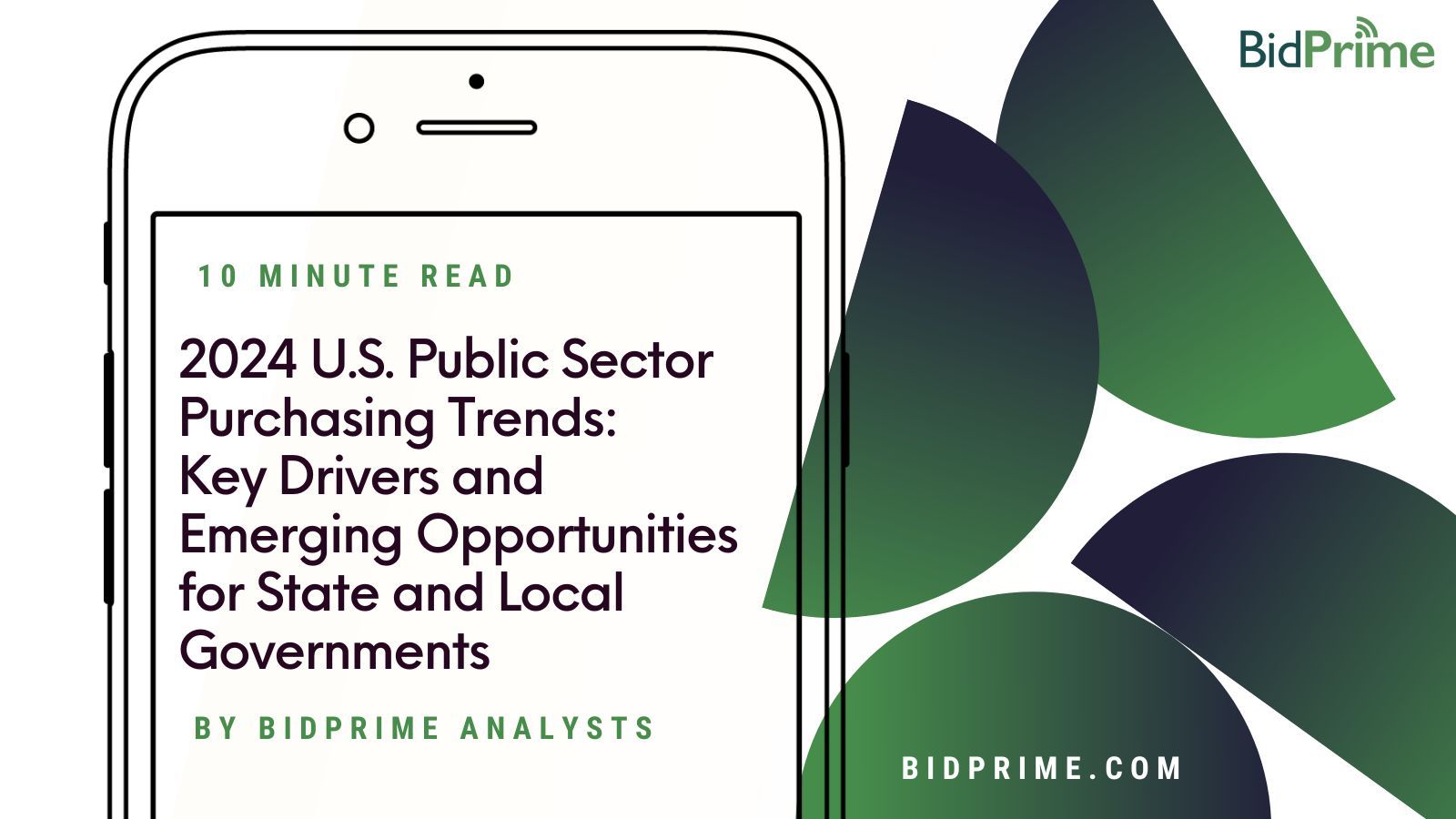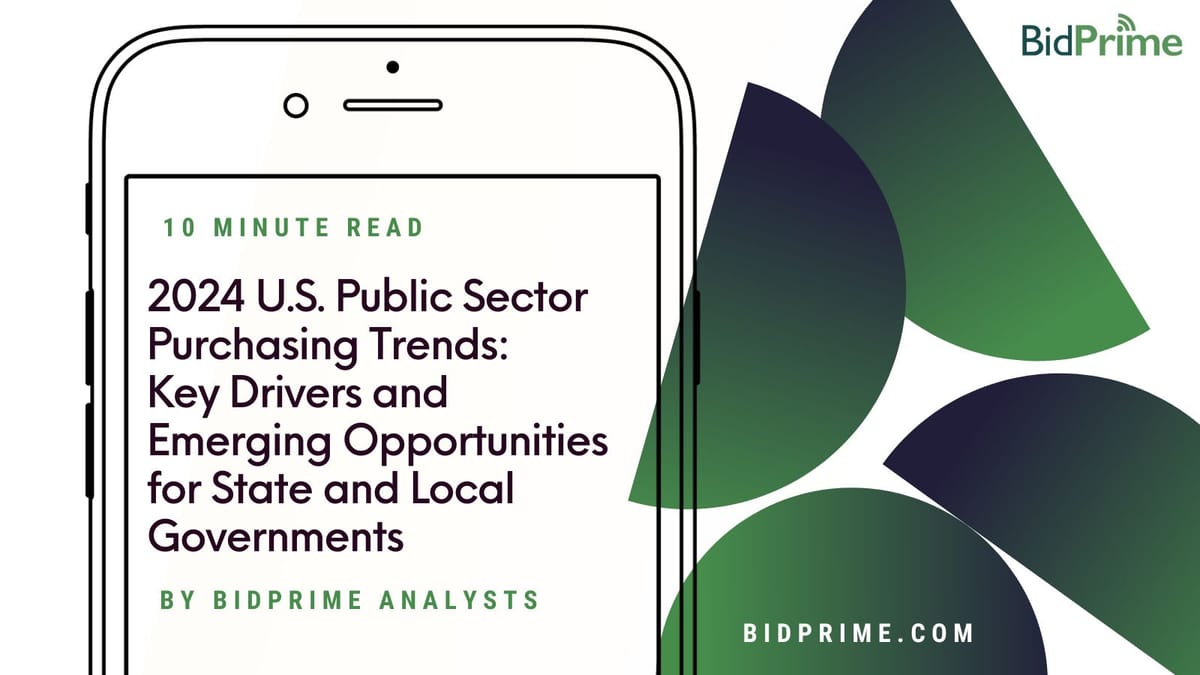
Introduction:
As we move into the final quarter of 2024, state and local government purchasing trends are being shaped by multiple factors, including federal funding, technological advancements, and changing societal needs. The effects of landmark legislation such as the Infrastructure Investment and Jobs Act (IIJA), coupled with an ongoing focus on sustainability and digital transformation, are driving procurement decisions across a range of sectors.
From critical infrastructure and cybersecurity to workforce development and smart city initiatives, public sector purchasing is evolving to meet both immediate demands and long-term goals. In this article, we analyze the top purchasing trends for the remainder of 2024, highlighting opportunities across various industries. Whether you are in procurement, technology, or construction, these insights, from our BidPrime research team, will help you better understand the shifting priorities in public sector spending.
1. Infrastructure Investment and Jobs Act (IIJA) Impact
The Infrastructure Investment and Jobs Act (IIJA) continues to reshape public sector investment, with more than $550 billion allocated to infrastructure over five years. For the remainder of 2024, state and local governments will continue focusing on projects funded through IIJA grants and allocations. Key areas include transportation infrastructure (roads, bridges, and railways), water and sewer systems, and broadband expansion to rural and underserved areas.
Our BidPrime analysts have followed a significant trend in the prioritization of resilient infrastructure capable of withstanding extreme weather events, floods, and wildfires. This means increased spending on stormwater management systems, coastal defenses, and upgrades to public facilities for improved disaster response. In addition, the IIJA is accelerating projects in sustainable energy, including solar and wind power installations. Contractors and service providers offering innovative solutions in these areas will likely see heightened demand as state and local agencies tap into these federal resources.
Sample Active Bids: “Infrastructure”
2. Technology and Cybersecurity
With rising threats to public networks and systems, cybersecurity is still at the forefront of public sector priorities. The State and Local Cybersecurity Grant Program (SLCGP) is driving spending in this area, with governments investing in cyber risk assessments, firewall protection, threat detection tools, and incident response services.
Cloud computing and data analytics are also receiving attention as governments seek to modernize their IT infrastructure. Local agencies are focusing on cloud migration, enabling more secure and flexible service delivery. Investments in big data tools and artificial intelligence (AI) will play a key role in improving decision-making capabilities across areas like emergency management, resource allocation, and social services. As governments continue to upgrade their digital capabilities, vendors specializing in network security, data storage, and AI-driven analytics platforms will find a fertile market.
Sample Active Bids: “Technology”
Sample Active Bids: “Cybersecurity”
3. Health and Human Services
In the health and human services sector, local governments are poised to invest in technology and infrastructure to better serve communities, across the United States. Telehealth services remain a priority, with expanded access to digital health platforms, particularly in underserved areas. These platforms help reduce barriers to care while enhancing patient management for chronic conditions. Public health agencies are also expected to invest in data-sharing systems, improving collaboration between hospitals, clinics, and emergency services.
Public health preparedness is also gaining attention, with more funds being allocated to emergency preparedness technologies. Procurement of rapid response systems, vaccine distribution technology, and emergency notification platforms is on the rise as governments aim to bolster their ability to manage health crises. Additionally, there’s a growing emphasis on workforce development programs, particularly those focused on public health and healthcare staffing.
Sample Active Bids: “Health”
4. Housing and Social Welfare
The housing sector is seeing increased activity, driven by the housing affordability crisis in many regions of the U.S. Expect state and local governments to continue prioritizing the construction of affordable housing and renovation of existing public housing units. Purchasing in this area will include modular construction solutions, energy-efficient building materials, and community development software to streamline project planning and management.
In tandem with housing, social welfare initiatives will expand, with governments seeking to provide holistic support for vulnerable populations. Solutions that address homelessness prevention, such as emergency shelters, housing management systems, and social service platforms, will see increased demand. Expect an uptick in non-profit collaboration and public-private partnerships aimed at tackling homelessness, especially in urban areas.
Sample Active Bids: “Housing”
Sample Active Bids: “Social Welfare”
5. Education and Workforce Solutions
Education remains a high priority, particularly as digital transformation continues to reshape K-12 and higher education. School districts and public universities will focus on procuring remote learning platforms, learning management systems (LMS), and tools that support STEM education. In addition to academic technologies, there is growing demand for physical upgrades to educational facilities to meet new safety standards and energy efficiency goals.
On the workforce front, public agencies are investing in job training programs aimed at addressing skills gaps in key industries like healthcare, technology, and manufacturing. Governments are increasingly partnering with vocational schools and community colleges to facilitate these programs, which are often supported by grants and federal funding. Vendors offering solutions that enhance workforce development and talent placement are likely to benefit as public sector spending in these areas increases.
Sample Active Bids: “Education”
Sample Active Bids: “Workforce Solutions”
6. Transportation and Mobility
Public sector purchasing in the transportation sector is expanding due to the continued push toward electric vehicle (EV) adoption and smart transportation solutions. Many state and local governments are working to replace traditional government vehicle fleets with electric buses, police vehicles, and public works vehicles. In addition, investments in EV charging stations and related infrastructure are expected to grow significantly in the final quarter of 2024.
Beyond electrification, transportation departments are investing in intelligent traffic management systems, vehicle-to-everything (V2X) technologies, and smart city mobility platforms. These solutions aim to reduce congestion, improve public transit efficiency, and enhance the overall quality of urban mobility. The mobility-as-a-service (MaaS) model is gaining traction, with procurement in areas such as shared transportation services, bike-share systems, and real-time transit tracking apps.
Sample Active Bids: “Transportation”
Sample Active Bids: “Mobility”
7. Energy and Utilities
As part of ongoing efforts to meet climate goals, public sector agencies are set to invest heavily in grid modernization and renewable energy solutions. This includes smart grid technologies to improve energy distribution and resilience against extreme weather events. Expect increased purchasing in solar energy projects, wind power installations, and energy storage systems, particularly in states with aggressive sustainability goals.
The energy sector will also see significant investments in microgrids and distributed energy resources (DER), aimed at enhancing energy reliability and independence. In disaster-prone regions, governments are prioritizing resilient energy solutions, including backup power systems and emergency energy distribution networks.
Sample Active Bids: “Energy”
Sample Active Bids: “Utilities”
8. Justice and Public Safety
Finally, public safety remains a key area of government investment. Law enforcement and emergency management agencies are continuing to upgrade their public safety technology, including predictive policing tools, body cameras, and emergency response systems. Procurement of drones for surveillance, automated license plate readers, and smart 911 systems is on the rise as agencies look to improve both proactive and reactive response capabilities.
There’s also an emphasis on community policing technologies, which enhance transparency and trust between law enforcement and the communities they serve. These include data-driven crime mapping tools and civilian oversight software. As local governments seek to strengthen public safety while managing resources efficiently, this will drive demand for cost-effective, high-performance solutions.
Sample Active Bids: “Justice”
Sample Active Bids: “Public Safety”
Conclusion:
The remainder of 2024 is set to be a pivotal period for public sector purchasing as state and local governments continue to focus on infrastructure, digital transformation, sustainability, and public safety. BidPrime continues to provide the solutions to help businesses identify and qualify the opportunities important to them. Among the tools are Emerging Opps (EOPPS) which allows BidPrime customers to take advantage of complete local government agency coverage, including agendas, minutes, budgets, plans, and video, with the added layer of AI to automatically discover opportunities. In addition, Future Opps (FOPPS) equips customers to identify term contract data from state contract resources. FOPPS delves into large, medium, and small agency specifications, predicting well over 100,000 future opportunities released by agencies in the coming years, involving more than 50,000 awarded vendors. Thousands are being added every day.
The ongoing distribution of federal funding, particularly from the Infrastructure Investment and Jobs Act, is providing the financial backbone for many of these initiatives. Understanding the key areas where governments are directing their purchasing power offers significant opportunities for vendors, contractors, and service providers. Whether it’s offering cutting-edge technology solutions, construction services, or public safety tools, aligning with public sector priorities will be crucial to capturing this market. Are you and your business positioned to know about these opportunities?
BidPrime will ensure our customers stay ahead by monitoring these trends and positioning your solutions to meet the evolving needs of the public sector in 2024 and beyond. For more information, visit BidPrime or learn more about Emerging Opps and Future Opps.

